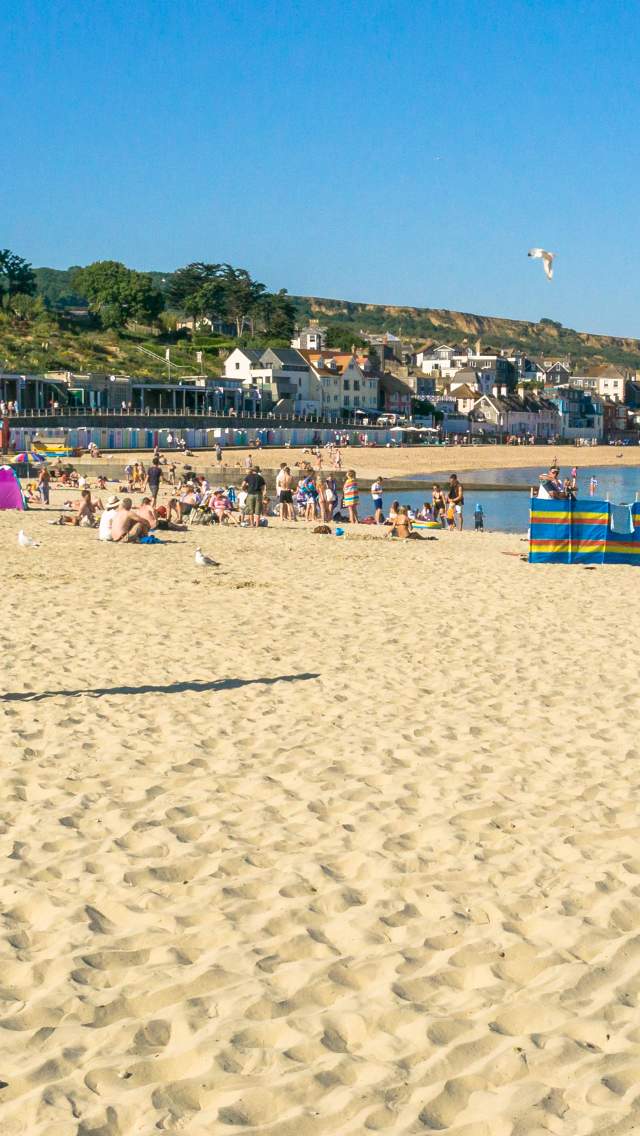Beaches at Lyme Regis
Lyme Regis has lots of different beaches to choose for your day out by the sea.
Sandy beaches perfect for sandcastles, quiet pebble beaches away from the crowds and some of the best beaches in the world to find fossils.
Front Beach
Front Beach is a family friendly beach near the Cobb harbour. The beach is split into a sandy beach nearest the harbour with an adjacent pebble beach divided by a stone jetty.
Because this is the town’s only sandy beach, it is very popular in summer. RNLI lifeguards patrol the sandy section of beach during the peak season, so it's the ideal place to swim and paddle.
Next to the beach you’ll find the Cart Road – a long flat promenade suitable for pushchairs and wheelchairs. There is beach matting which allows access for wheelchairs onto the beach. Plus, there are two beach wheelchairs and one floating wheelchair which can be hired for free from the town council (booking in advance is required).
At the back of the beach there are colourful beach huts which you can hire from the town council for the day or week. Perfect for a seaside escape – whatever the weather.
If you fancy an ice-cream or something for lunch, a short walk along the promenade brings you to beachside kiosks, cafes, restaurants and pubs.
Monmouth Beach
Monmouth Beach is a mile-long stretch of pebble beach adjacent to the Cobb wall. It is steeped in history, both modern day and prehistoric.
The beach takes its name from the Duke of Monmouth who landed beside the Cobb in 1685 to launch a rebellion against his uncle, King James II.
Next to this beach you will find holiday chalets, beach huts, the bowling green, Lyme Regis Power Boat Club and beachside car parks.
Monmouth Beach is the access point for the Undercliffs National Nature Reserve and the South West Coast Path towards Axmouth in Devon.
The beach is popular with fossil hunters as ammonites, belemnites, fossil plants and even ichthyosaur vertebrae have been found here. The cliffs here are said to date from 189 to 199 million years ago, formed in the early Jurassic period when warm, tropical seas covered most of the UK.
If you walk to the far end of the beach at low tide, you will find the ammonite graveyard (also known as the ammonite pavement). It is a layer of limestone rock famous for the large ammonite fossils that it contains. Be sure to always check the tide times before setting out as the beach can get cut off at high tide.
Church Cliff Beach
Church Cliff Beach is a small pebble and sand beach in front of Gun Cliff Walk near the Marine Theatre.
At low tide there is an extensive rock ledge with hundreds of rock pools.
The River Lim flows into the bay on this beach so you will have to paddle if you want to walk along the sands. The beach is covered at high tide.
East Cliff Beach
East Cliff Beach (known locally as Back Beach) can be found northwest of the town heading towards Charmouth. This end of Lyme Regis offers panoramic views of the Jurassic Coast, including views to Golden Cap (the highest point on the south coast) and some of the best fossiling beaches in the world.
This fossil-rich beach can be accessed from the town centre via Church Cliff Walk.
Check tides before you set out because the beach can be cut off at high tide and please be aware that there may be some debris on the beach from a former landfill site at the top of the cliff which was closed in the early 1970s which has been subject to costal erosion..
The nearest car park is at Charmouth Road which is connected to the promenade by 114 steps.
The cliffs to the back of the beach are called The Spittles. The dark grey cliffs further along the coast towards Charmouth are called Black Ven and this is where the famous fossil collector Mary Anning found her first Ichthyosaur fossil. Black Ven is the largest mudslide in Europe, which is actively slipping and being eroded by rain and sea, releasing fossils from the Blue Lias and Charmouth Mudstone formations. The cliffs are very unstable with extensive mudflows in places and should be admired from a distance.
Scour the beach to find ammonites, belemnites and the odd vertebrae. Crinoids (ancient starfish), fossil fish, ichthyosaurs, plesiosaurs and even a scelidosaurus, unique to the mile of coast between Lyme and Charmouth, have been rarer finds here.
If you would like expert guidance, there are fossil walks running most months of the year from Lyme Regis Museum and by local guided tours.
Dogs and the beaches
Dogs are allowed off lead on East Cliff Beach, Church Cliff Beach and Monmouth Beach all year round. Dogs are only allowed at Front Beach from 1 October to 30 April, inclusive.
Dogs must also be kept on the lead at all times when using Marine Parade, Cart Road, Bell Cliff, the harbour, slipway and sea walls, entrance to Cobb Road, Ozone Terrace, entrance to the public car park and boat park, harbour wall, Cobb Gate car park, Gunn Cliff Walk, Church Cliff Walkway, and the steps leading from Church Cliff Walkway to Charmouth Road car park.
Plan Your Visit
We  coastal activities
coastal activities
Embrace Coastal Activities
Lyme Regis is a perfect destination for sea lovers seeking an unforgettable experience. Discover the...
Explore more...
Fossils
Discover your own fossil from the Jurassic seas of 180 million years ago!
The Cobb
The Cobb harbour is a great place to enjoy amazing coastal views of the Jurassic Coast.
Beach Huts
Book a beach hut for your stay
Parking
There are a lots of short and long stay parking, some have EV chargepoints for electric vehicles.









